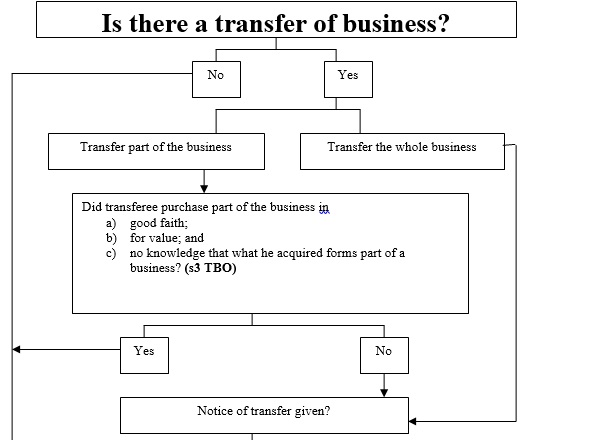Legal issues in Transfer of Business
Transfer of Business (Protection of
Creditors) Ord., Cap. 49
1.
Whenever
a business is transferred[1]
(with or without goodwill), the transferee shall become liable for all the
debts and obligations arising out of the carrying on of the business by the transferor:
S.3 TBO. Such liabilities are
imposed irrespective of any contrary agreement between the transferor and the
transferee.
2.
Where
only a part of a business is transferred and the transferee purchased such part
of the business in good faith and for value and had no knowledge that what he
acquired formed part of a business, he shall not be so liable.
3. A transferee shall not become liable for such liabilities if a notice of transfer has been given (not more than 4 months and not less than 1 month before the date of transfer) and has become complete at the date of transfer: S.4(1) TBO.
3.1 A
notice of transfer must be given in the prescribed form.
3.2 A notice
becomes complete upon the expiration of 1 month after the date of the last
publication of the notice. The notice
must be published in the Gazette, 2 Chinese language and 1 English language
newspapers. It is the date of the last
notice that counts.
3.3 Late
Notice - Where a notice is given late (i.e. less than 1 month before the date
of transfer), the liability of the transferee ceases when the notice becomes
complete: S. 4(2) TBO.
3.4 Subsequent
Notice - Where no prior notice is given before the date of transfer, the
liability of the transferee shall not cease until such a notice has been given
and become complete: S.4(3) TBO.
4.
A
notice is deemed incomplete i.e. the transferee remains liable, if:
4.1 where
the notice of transfer has become compete at the date of transfer, proceedings are instituted against the
transferor before the notice has become complete; or
4.2 where
the notice of transfer has not become complete at, or where no notice was given
at all before, the date of transfer, proceedings are instituted against the
transferee before the notice has become complete.
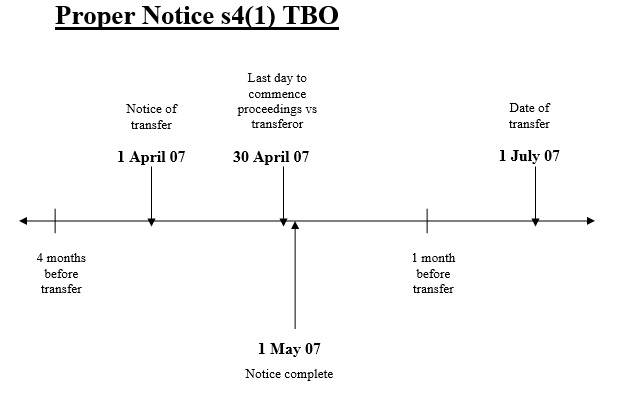
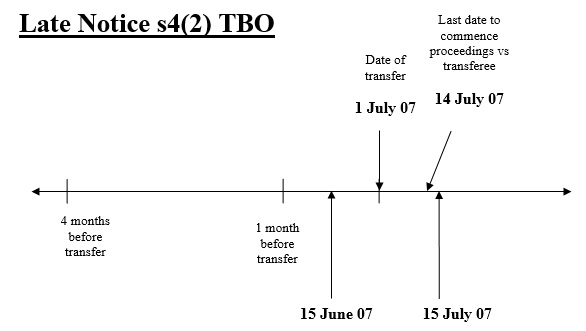
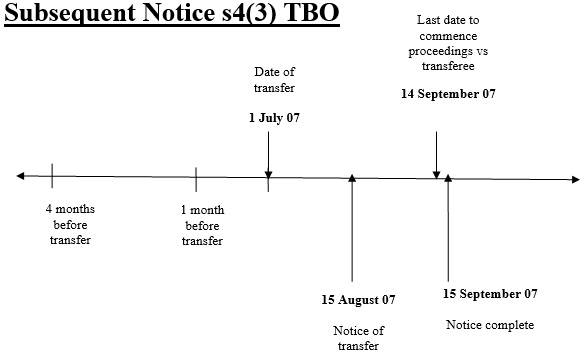
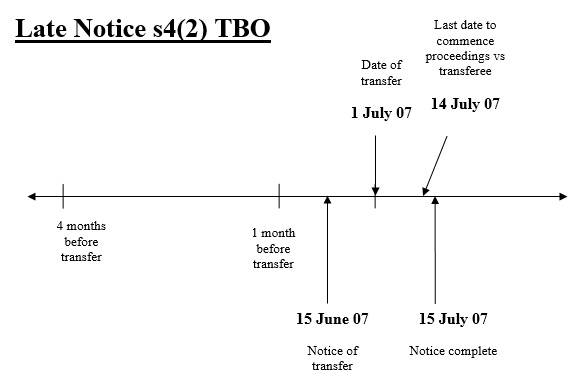
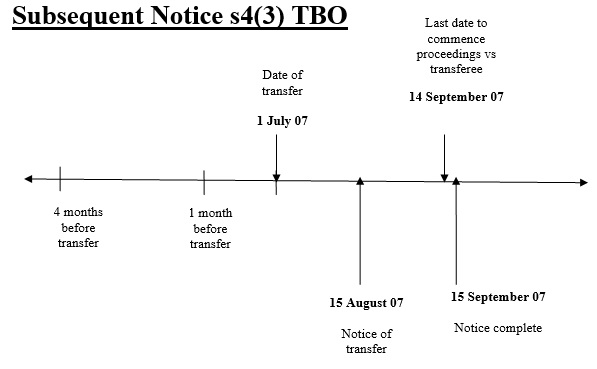
5.
Proceedings
must be served upon the transferor or the transferee, as the case may be,
within 1 month of commencement.
Alternatively, a written notice of the proceedings must be sent by
registered post to the last known address of such transferor or transferee.
6.
A
transferee’s liability under TBO is limited to the value of the business
acquired by him (value as at the date of transfer) provided he has paid to the
creditors in discharging his liabilities under TBO in good faith and without
preference an amount equal to the value[1]: S.8
TBO. The value is presumed to be the
amount paid or agreed to be paid for the acquisition, unless the contrary is
proved.
7.
A
creditor is not entitled to institute any action against a transferee for
liabilities under TBO more than 1 year after the date of transfer: S. 9 TBO. This is an absolute bar, irrespective of
whether any notice of transfer has been given[2].
8.
The
transferee is entitled to be indemnified by the transferor (or charge-holder if
sale under charge) for all the amounts for which the transferee is made liable
under TBO: S6 TBO.
9.
The
pre-existing liabilities of the transferor are not affected or relieved under
the TBO: S. 7 TBO.
10.
TBO
does not apply to any transferee where the transfer is effected by the Official
Receiver, a trustee in bankruptcy, a liquidator of a company in liquidation
(excluding one appointed under voluntary winding-up) or, a charge-holder whose
charge has been registered for not less than 1 year before the date of transfer
etc.: S.10 TBO.
**********************************************************************
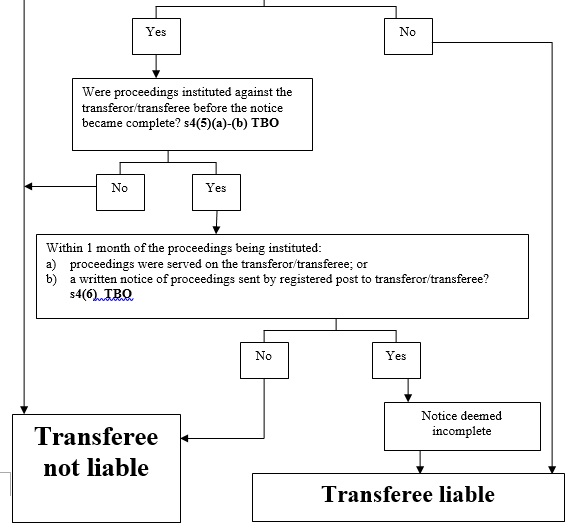
CASE STUDIES
REFCO, INC v TROIKA BULLION LTD & OTHERS, [1989] HKLY 869
P was a creditor of X and in an action to recover debts claimed
that X had transferred its business to "Y, formerly known as D".
After the limitation period under s.9 of the Transfer of Businesses (Protection of
Creditors) Ordinance had expired, P asked for leave to amend the writ and the statement of claim so as to change the
description of the first defendant from "Y formerly known as D" to
simply "D", alleging that the business had been transferred to
D and/or to Z.
The defendants sought to strike out the first defendant D and the
fourth defendant Z. P then proposed to rename the first defendant as "Z
formerly known as X" and to strike out Z as the other defendant,
thereby substituting Z as the first defendant.
Held, dismissing the action, that
(1) P's mistake was a mistake as to the identity of the defendant it
was suing, not merely a mistake as to the name of that defendant;
(2) O.20 r.5(3) permitted an amendment only to correct a genuine mistake as to the name of a defendant. It allowed this to be done even after the expiry of a relevant period of limitation. But at the same time it required the court to be satisfied that the mistake was not misleading and not such as to create any reasonable doubt as to the identity of the person intended to be sued. P's mistake was misleading, and did cause such a reasonable doubt;
(3) O.15 r.6 would not avail P as it would be wrong to substitute one
defendant for another when the claim against the original defendant was
statute-barred, unless the case was one which fell within O.20 r.5(3) (Evans
Construction Co Ltd v Charrington & Co Ltd [1983] 1 QB 810 (CA) referred to).
BNP PARIBAS v GC LUCKMATE TRADING LTD [2003] 1 HKLRD 307
(Court of Appeal)
At first instance, it was held that within the meaning of TBO, B
had transferred its business to D, such that D was liable for B's liabilities;
and that D was not entitled to invoke s.8 which entitled a transferee to cap
its liability to the value of the transferor's business at the date of the
transfer. D was ordered to pay P, a creditor of B, US $999,162.62. D appealed
on the availability of s.8. D had paid US$1 for B and argued as the liabilities
of B far exceeded its assets, US$1 should be presumed to be the correct value
and its liability should be limited to this amount.
Held, dismissing the appeal, that:
(1) As it was D seeking to derive a benefit from s.8, the burden
of proof lay on D to establish that the provision was applicable. Section 8 was
not available to D because it could not prove that it had given true value
consideration for B. The purely notional sum paid in consideration with nothing
having been paid to the creditors, meant that D was able to take advantage of
the assets and goodwill of the business while at the same time shedding the
responsibility for the liabilities of B. The scheme was undoubtedly designed to
defeat the claims of B's creditors.
(2)
A
transferee can only obtain the benefit of s.8 if it can prove that it has made
or agreed to make a payment to the transferor and it has paid the creditors.
The burden of establishing this must lie upon the transferee who is seeking to
assert it
Lifting the Corporate Veil
1. Sham
or facade means what is apparent is not real. Ordinary meaning of ‘sham or
facade’ was explained by Diplock LJ in Snook
v London and West Riding Investments Ltd [1967] 2 QB 786, 802 as meaning:
“acts done or documents executed by the parties to the
‘sham’ which are intended by them to give to third parties legal rights and
obligations different from the actual legal rights and obligations (if any)
which the parties intend to create”.
2. Whenever corporate form
is alleged to be a ‘facade’, a ‘device’ or ‘sham’ or ‘cloak’ to perpetrate a
wrong, the motive of the alleged perpetrator is a relevant factor. See: Ord
v Belhaven Pubs Ltd [1998] 2 BCLC 447, per Hobhouse LJ at 457
LIU HON YING v HUA XIN STATE ENTERPRISE (HONG KONG) LTD
[2003] 3 HKLRD 347
C ran a business. A debt
was owed by C to P. At the time when P
started claiming against C, D was already incorporated and commenced business.
The ultimate controlling shareholder behind C and D gradually and continuously
channelled C's business to D and eventually to E. C did not defend P's claim
against it as the common controller had already given C up.
C, D and E all ran the same delivery business and, inter alia, had
the same customers, the same offices, same staff and the same system of work,
the same key equipment, and the same telephone and fax numbers, etc.
P, in its claims against D and E, contended: (1) that within the
meaning of the Transfer of Businesses (Protection of Creditors) Ordinance,
there had been a transfer of business and assets from C to D and subsequently
also from D to E; and (2) D commenced business partly to evade the existing
liability of C, the corporate veil of C and D ought, therefore, to have been
lifted.
Held: This was a classical case where D's corporate veil should be
lifted. D was not incorporated to avoid liability but to conceal true facts and
thereby evade liability.
Using a corporate structure to avoid the incurring of any legal
obligations in the first place was not objectionable. The court's power to lift
the corporate veil did not exist for the purpose of reversing such avoidance so
as to create legal obligations.
However, using a corporate structure to evade legal obligations
was objectionable. The court's power to lift the corporate veil might be
exercised to overcome such evasion so as to preserve legal obligations (China
Ocean Shipping Co v Mitrans Shipping Co Ltd [1995] 3 HKC 123, Customs
and Excise Commissioners v Hare [1996] 2 All ER 391, Trustor
AB v Smallbone (No 3) [2001] 1 WLR 1177
applied).
SMELOAN HONG KONG LTD V WONG WING CHEUNG TRADING AS HUNG
WAN TRADING COMPANY [2006]
HKCU 1881
P is a
finance company which made certain credit facilities to H, a textiles trading
company. H’s business did not flourish so P terminated the credit facilities
and sued H for outstanding sum. P obtained default judgment. Judgment debt
remained unpaid. Hence, P sued D instead, on the basis that D is the transferee
of H’s business. D denied there was a transfer of business and contended that
he was operating a new business.
Issues:
1) Was
there a business to transfer? D’s argument was that since the business of H had
ceased to exist at the time D took over, there was no business to transfer.
2) Was
there a transfer of business?
Held:
As to
Issue 1 –
Court held that it is not necessary for the business
alleged to be transferred to be substantial or of any particular level of value
so long as there is at least something left in the way of assets or goodwill.
Court found that although the business might have been
on the verge of bankruptcy, the business had not ceased to exist and there was
a residual business (and goodwill) of H to be transferred to D.
Evidence:
(a) No formal cessation of business of H
before D commenced business.
(b) No evidence of any notices having
been given to the customers of H.
(c) Former customers of H continued to
purchase textiles from D.
(d) D took over stock, furniture and
machine previously belonged to H.
(e) D’s business employed the same staff
as H for one month after D had taken over the business.
As to
Issue 2 –
Court
found that there was a transfer of business.
Evidence:
(a) An agreement was reached between the
shareholders of H to transfer the business of H in order to set off the sum D
had lent to H.
(b) One of H’s shareholders was in fact
D’s wife.
(c) The same shop premises was used by D.
(d) D took over stock, furniture and machine
previously belonged to H.
(e) Although the names of the 2
businesses were different, D continued to carry on the same business and served
at least some of the old customers.
[1] As per Deputy Judge Reyes in BNP
Paribas v Luckmate [2002] HKLRD 156:
“From
the above survey of case law, I derive the following principles:
(1) In deciding whether there has been a transfer of business
under the TBO, the court objectively considers all surrounding circumstances.
The fact that there is no document formally evidencing a transfer is not
conclusive.
(2) A transfer of assets may indicate a transfer of business. But
a transfer of assets does not of itself mean that there has been a transfer of
business within the TBO.
(3) There may be a transfer where the alleged transferee can be
shown to have gained some advantage from taking over the purported transferor's
business. Such advantage will often arise because the alleged transferee is
shown to have taken over a 'going concern'. But even where an entity is on the
verge of bankruptcy, an alleged transferee may perceive a real benefit to be
gained from assuming some or all aspects of that entity's business.
(4) Factors indicating that a business has been transferred from
one person to another include the following:
(a) Use of the same or similar name.
(b) Assignment of goodwill.
(c) Use of the same premises.
(d) Use of the same fixtures, fittings and equipment.
(e) Use of the same personnel.
(f) Use of the same stock-in-trade.
(g) Conduct of the same or similar type of business.
(h) Conduct of business in the same or similar manner.
(i) Servicing of the same customers.
Although the above may not be conclusive individually, the
cumulative presence of a number of the foregoing factors can establish a
transfer.”
[2] The transferee only enjoys this limitation of liability, if he has discharged liabilities arising under the Ordinance 'in good faith and without preference '. If the transferee is ignorant of some creditors who have a claim, he may well inadvertently prefer other creditors who have similar claims. The transferee's intention seems irrelevant (cf Richards & Co Ltd v Lloyd (1933) 49 CLR 49) and it is arguable that the limitation on liability will not apply at all unless the transferee pays all creditors rateably up to the limit. If this is so, the protection offered by the subsection is extremely limited (see PG Willoughby & WJL Knight, ‘Transfer of Businesses (Protection of Creditors) Ordinance’ (1980) 10 HKLJ 348, p.354): The annotated Ordinances of Hong Kong [8.02]
[3] As per Yam J in Liu Hon Ying v
Hua Xin State Enterprise [2003] 3
HKLRD 347:
“Alternatively,
on the proper construction of the Ordinance, the plaintiff submitted that s.9
only operates to bar an action against the transferee personally, and it does
not in any way seek to extinguish the liability of the transferee or to cause
such liability to cease. I accept the plaintiff's submission. Under the same
Ordinance when the Legislature intends that the statutory liability shall
cease, meaning that the transferee shall be free from such liability, it will
expressly provide that such liability 'shall cease' as in s.4(3) by giving of
the notice of transfer.
Section 9 is distinguishable from the express provision of
extinguishment of a registered owner's title to landed property under s.17 of
the Limitation Ordinance (Cap.347), which is over and above s.7 of that
Ordinance which provides for limitation to commence action. The scheme
therefore would positively extinguish title to land of a registered owner by
the lapse of time.
In the
premises under the scheme of the present Ordinance, the statutory liability of
transferee continues in law but only that by s.9 no action by creditors could
be instituted against the transferee in the courts of law. Thus, the effect of
the Ordinance would be effective when there were successive transfers with no
statutory notice being given because of deliberate concealment or otherwise.
The creditors may find themselves unable to sue the first transferee due to the
lapse of time which may be for no fault on their part. However, they should be
able to catch the last transferee if the actions against the previous
transferees could not be pursued by reason of the time-bar provided under s.9.
| For enquiries, please contact our Litigation & Dispute Resolution Department: |
E: ldr@onc.hk T: (852) 2810 1212 W: www.onc.hk F: (852) 2804 6311 19th Floor, Three Exchange Square, 8 Connaught Place, Central, Hong Kong |
| Important: The law and procedure on this subject are very specialised and complicated. This article is just a very general outline for reference and cannot be relied upon as legal advice in any individual case. If any advice or assistance is needed, please contact our solicitors. |
| Published by ONC Lawyers © 2007 |






